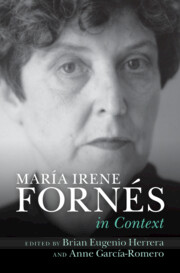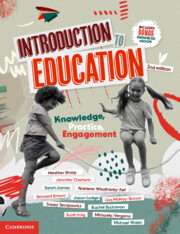Refine search
Actions for selected content:
67 results

María Irene Fornés In Context
-
- Published online:
- 27 August 2025
- Print publication:
- 07 August 2025
Chapter 28 - Boulez as Teacher
- from Part V - Multiple Activities
-
-
- Book:
- Boulez in Context
- Published online:
- 08 July 2025
- Print publication:
- 24 July 2025, pp 293-302
-
- Chapter
- Export citation

Introduction to Education
- Knowledge, Practice, Engagement
-
- Published online:
- 14 June 2025
- Print publication:
- 02 June 2025
-
- Textbook
- Export citation
Chapter 9 - How do I assess, provide feedback and report on learning?
- from Part 2 - Understanding learning and understanding teaching
-
-
- Book:
- Introduction to Education
- Published online:
- 14 June 2025
- Print publication:
- 02 June 2025, pp 214-239
-
- Chapter
- Export citation
Chapter 2 - How do I prepare to be a teacher?
- from Part 1 - Introduction to education
-
-
- Book:
- Introduction to Education
- Published online:
- 14 June 2025
- Print publication:
- 02 June 2025, pp 27-56
-
- Chapter
- Export citation
Chapter 14 - When do I stop learning?
- from Part 4 - Developing professional practice
-
-
- Book:
- Introduction to Education
- Published online:
- 14 June 2025
- Print publication:
- 02 June 2025, pp 369-391
-
- Chapter
- Export citation
Chapter 4 - Who are my students?
- from Part 1 - Introduction to education
-
-
- Book:
- Introduction to Education
- Published online:
- 14 June 2025
- Print publication:
- 02 June 2025, pp 81-106
-
- Chapter
- Export citation
Chapter 11 - How do I create and maintain safe and supportive learning environments?
- from Part 3 - Working in education contexts
-
-
- Book:
- Introduction to Education
- Published online:
- 14 June 2025
- Print publication:
- 02 June 2025, pp 288-314
-
- Chapter
- Export citation
Chapter 5 - How do students learn?
- from Part 2 - Understanding learning and understanding teaching
-
-
- Book:
- Introduction to Education
- Published online:
- 14 June 2025
- Print publication:
- 02 June 2025, pp 108-127
-
- Chapter
- Export citation
Chapter 6 - Why are students taught a particular curriculum?
- from Part 2 - Understanding learning and understanding teaching
-
-
- Book:
- Introduction to Education
- Published online:
- 14 June 2025
- Print publication:
- 02 June 2025, pp 128-149
-
- Chapter
- Export citation
Chapter 13 - How do I make the most of professional experience?
- from Part 4 - Developing professional practice
-
-
- Book:
- Introduction to Education
- Published online:
- 14 June 2025
- Print publication:
- 02 June 2025, pp 340-368
-
- Chapter
- Export citation
Chapter 3 - Why is the education system organised this way?
- from Part 1 - Introduction to education
-
-
- Book:
- Introduction to Education
- Published online:
- 14 June 2025
- Print publication:
- 02 June 2025, pp 57-80
-
- Chapter
- Export citation
Chapter 8 - How do I implement effective teaching and learning?
- from Part 2 - Understanding learning and understanding teaching
-
-
- Book:
- Introduction to Education
- Published online:
- 14 June 2025
- Print publication:
- 02 June 2025, pp 181-213
-
- Chapter
- Export citation
Chapter 7 - How do I plan for effective teaching and learning?
- from Part 2 - Understanding learning and understanding teaching
-
-
- Book:
- Introduction to Education
- Published online:
- 14 June 2025
- Print publication:
- 02 June 2025, pp 150-180
-
- Chapter
- Export citation
Chapter 10 - What is in a teacher’s toolkit?
- from Part 2 - Understanding learning and understanding teaching
-
-
- Book:
- Introduction to Education
- Published online:
- 14 June 2025
- Print publication:
- 02 June 2025, pp 240-286
-
- Chapter
- Export citation
Chapter 12 - How do I work with colleagues, parents/caregivers and the community?
- from Part 3 - Working in education contexts
-
-
- Book:
- Introduction to Education
- Published online:
- 14 June 2025
- Print publication:
- 02 June 2025, pp 315-338
-
- Chapter
- Export citation
The East London Classics Summer School 2024
-
- Journal:
- Journal of Classics Teaching / Volume 26 / Issue 51 / Spring 2025
- Published online by Cambridge University Press:
- 06 November 2024, pp. 99-100
-
- Article
-
- You have access
- Open access
- HTML
- Export citation
Chapter 10 - It’s just the beginning
- from Part 4 - Beyond the classroom and into the future
-
- Book:
- Teaching for Linguistic Diversity in Schools
- Published online:
- 25 October 2024
- Print publication:
- 27 June 2024, pp 193-204
-
- Chapter
- Export citation
Charity Scott – A Masterful Teacher
-
- Journal:
- Journal of Law, Medicine & Ethics / Volume 52 / Issue 2 / Summer 2024
- Published online by Cambridge University Press:
- 22 October 2024, pp. 224-227
- Print publication:
- Summer 2024
-
- Article
- Export citation
Chapter 16 - Goethe’s Drawings
- from Part III - Art
-
-
- Book:
- Goethe in Context
- Published online:
- 16 May 2024
- Print publication:
- 23 May 2024, pp 150-165
-
- Chapter
- Export citation
